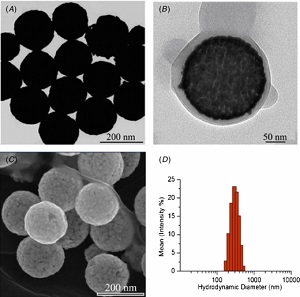 |
| Gold nanoshells used to deliver chemotherapy and infrared hyperthermic treatments--Courtesy of the Institute of Physics |
Researchers in China published an article in the journal Biomedical Materials demonstrating the drug-delivery potential of new gold nanoshells for cancer that also use hyperthermic effects to bring toxic cancer drugs to tumors with fewer side effects.
Gold-based nanoparticles have been used in various forms of drug delivery for years, but researchers are beginning to fine-tune their abilities to specifically target tumor cells without affecting surrounding healthy cells in the process. By assigning multiple functionalities to the nanoparticles, the researchers from East China Normal University and Tongji University showed that gold-based delivery could reach another level of targeting distinction.
First of all, the nanoshells themselves display a resonance that absorbs near-infrared light and disperses it as heat. This hyperthermic effect has been shown to manipulate a tumor's environment to help chemotherapeutic agents enter the cell and optimize the result. And by using these gold nanoparticles to deliver the common cancer treatment doxorubicin with the added targeting capability of a protein called A54, the researchers were able to improve the cellular uptake of the gold nanoparticles in liver cancer cells.
The experiment, performed in vitro, showed that the combination of chemotherapy and heat "exhibited a clear synergistic effect," according to the journal article. And the entire treatment was tumor-selective, leaving normal cells alone--the nanoshells with the targeting protein had three times greater uptake in the liver cancer cells.
"The therapeutic activity of most anticancer drugs is limited by their systematic toxicity to proliferating cells, including some normal cells," lead author Shunying Liu of East China Normal University said in a statement. "Overcoming this problem remains a great challenge for chemotherapy. … The next step of our research is to test the 'smart' gold nanoshells in vivo on a liver cancer mouse model. We will also examine how the size of the nanoshells changes their efficacy and how efficient the nanoshells are at converting near-infrared light into heat."
- here's the Institute of Physics report
- and the Biomedical Materials article